Wharton management professor Lindsey Cameron was so committed to her research on gig workers that she became one, driving part-time for Uber for three years as she studied how people in the sharing economy give meaning to their work.
Her time spent as both a driver and a passenger helped Cameron forge a deeper understanding with the 63 ride-hailing drivers she interviewed over five years for her formal study. Questioning them, she drew out intimate details about their experiences and learned about the mental games they play to find satisfaction in jobs that are transactional, temporary, and downright lonely at times.
“There’s a cultural narrative that the gig economy is so terrible and so exploitive,” Cameron said. “I honestly came into the research thinking that was true, but that’s not what many of the drivers told me. They really liked it.”
Her paper, “Making Out While Driving: Relational and Efficiency Games in the Gig Economy,” which was recently published in the journal Organization Science, adds to a growing body of research into what is quickly becoming the new normal for many — workplaces without walls, bosses, co-workers, or any of the traditional structures that keep employees engaged and socially connected. As many as 55 million Americans were gig workers in 2017, a figure that has risen during the COVID-19 pandemic. And policy debates continue over whether those workers should be classified as employees who deserve benefits.
“We’re going into a world where there are weaker organization and occupational mechanisms for socialization. You can get hired by a company and work there and never talk to a single person face to face,” Cameron said. “It raises the question of what keeps people in the work game? Hopefully, this paper is helping you understand what it’s like to be literally in the driver’s seat.”
“Hopefully, this paper is helping you understand what it’s like to be literally in the driver’s seat.”–Lindsey Cameron
In her analysis, Cameron found that ride-hailing drivers played two different games to keep themselves engaged. She classified them as:
- The relational game — Drivers bond with their passengers and provide excellent customer service in order to get a great review on the company’s app, which uses an algorithm-based rating system. They develop a mutually beneficial, amicable relationship with the app as they constantly track their ratings and get positive feedback.
- The efficiency game — Drivers complete work quickly at the highest pay rate and manage passengers by minimizing personal contact. Unable to accurately track their efforts through the app, drivers develop an adversarial relationship with it. They often create their own tracking tools and sometimes resort to manipulating the platform’s algorithm to “win.”
The study is filled with eye-opening anecdotes from Cameron’s interviews that show how drivers play the relational game by going the extra mile to engage their customers. One spoke about consoling a despondent, suicidal passenger until the man felt calm (“It was a good ride for me”). Another described how providing free water and snacks to hungry riders after a football game made them so grateful that they called him the greatest driver ever (“It made their day”). Others decorated their car interior with unicorn decals or played music that would deliberately spark friendly conversation with their passengers.
These drivers didn’t report getting more tips because of their efforts, Cameron said. Instead, what motivated them to provide a higher level of service was a sense of professionalism and purpose. Many of the relational-game drivers described themselves as tour guides, counselors, and sounding boards for passengers who just needed a friendly ear. Sometimes their actions paid off in non-monetary ways, leading them to new friends, hobbies, or job contacts.
Cameron noted that these drivers often pulled out their smartphones while she interviewed them to show her the positive comments left by appreciative riders. For them, the app was a “benevolent algorithm” that offered support and guidance, much like a good co-worker.
“The app is a tangible reminder of a job well done… allowing for an instant emotional boost,” she wrote in the paper. “Many drivers reported checking their apps constantly, even outside of work shifts.”
In contrast, drivers who played the efficiency game had no interest in anything beyond getter their fares from one destination to another. They enforced social boundaries by not offering to help with luggage, for example, or complying with requests for a quick detour to McDonald’s (“I don’t want to make 17 cents a minute and… have you sitting back, eating fries, making my car smell like French fries”).
“The app is a tangible reminder of a job well done… allowing for an instant emotional boost.”–Lindsey Cameron
Many efficiency-game drivers were suspicious and distrustful of customers. So, they didn’t offer extra services, such as carrying luggage, to protect themselves from liabilities — for instance, being accused of theft. That distrust extended to the algorithm, which they saw as unhelpful in matching them to the best fares, inaccurate in calculating their pay, and even unholy. One driver told Cameron, “I know exactly who’s behind the algorithm’s decisions, and it’s not God.”
Not surprisingly, efficiency-game drivers were more likely to view gig work as a low-paying trap they wanted to escape from. One even compared ride-hailing to prostitution, where the company is the “pimp” and the riders are “the johns.”
“Overall, when playing the efficiency game, drivers were not able to see themselves as skillful or successful in the work, as they were painfully aware of the control wielded by [the company] and its algorithms,” Cameron wrote. “This led drivers to describe their relationship with [the company] as antagonistic and, at times, even destructive.”
One important takeaway from the study is that all gig workers didn’t always play one game or another; some changed their approach based on the circumstances. Another takeaway, although not explicit in the study, is the need for tech-based firms to put more consideration into their apps, which serve as the only link between the gig worker and the larger organization, she said.
“This tool is going out in the world, so the user interaction experience is very important,” Cameron said. “What’s more important is to recognize that people will have different motives, so how do you create the right tech infrastructure and give them enough scaffolding to play the game they want to play?”
Cameron said what surprised her most about her study was the contrasting perspectives she found among ride-hail drivers.
“I didn’t like driving because of the heavy congestion. I thought everybody was not going to like it, too. And lo and behold, a lot of people like it,” she said. “This paper is about trying to make sense of that, and it shows the value of qualitative research. One of the hallmarks of good, qualitative research is that you can get into the participants’ shoes.”





